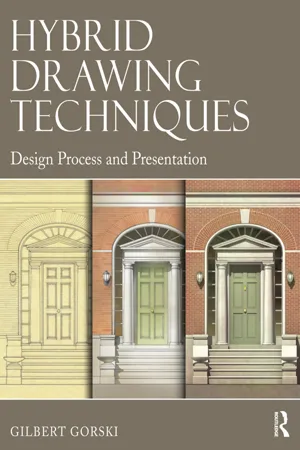
Hybrid Drawing Techniques
Design Process and Presentation
Gilbert Gorski
- 246 pages
- English
- ePUB (adapté aux mobiles)
- Disponible sur iOS et Android
Hybrid Drawing Techniques
Design Process and Presentation
Gilbert Gorski
À propos de ce livre
Hybrid Drawing Techniques: Design Process and Presentation reaffirms the value of traditional hand drawing in the design process by demonstrating how to integrate it with digital techniques; enhancing and streamlining the investigative process while at the same time yielding superior presentation images. This book is a foundations guide to both approaches: sketching, hardline drawing, perspective drawing, digital applications, and Adobe Photoshop; providing step–by–step demonstrations and examples from a variety of professional and student work for using and combining traditional and digital tools. Also included are sections addressing strategies for using color, composition and light to further enhance one's drawings. An eResource offers copyright free images for download that includes: tonal patterns, watercolor fields, people, trees, and skies.
Foire aux questions
Informations

Hybrid drawing technique: a process of first conceptualizing with hand-made drawings, and then using digital tools to confirm, refine, and document.
Traditional Drawing Limitations | Computer Advantages |
| 1 Favors concepts that are documented through orthographic drawings: plans, sections, and elevations. 2 Abstracts the process of creating 3D objects in a 2D environment. 3 Challenging to create complicated 2D and 3D geometry: intricate or repetitive patterns and subtle textures. 4 Traditional techniques can be cumbersome to merge into a digital environment. 5 Yields images corresponding to a single viewpoint. 6 Focuses creativity in one individual. 7 Individual means of expression invites subjective evaluation. 8 Requires many years of practice. 9 Integrated analytical capabilities are limited. 10 Changes can be difficult. 11 Does not easily facilitate fabrication of building components and systems. 12 Involves risk; variables concerning tools and individual skills can yield unpredictable results. | 1 Documents and quantifies organic or irregular objects; is not encumbered by 2D representation. 2 Facilitates creating 3D objects in a quasi-3D environment. 3 Anything imaginable can be realistically simulated in a digital environment. 4 The digital environment is the standard. 5 Capable of simulating movement with animation. 6 Capable of linking and simultaneously combining many contributors’ efforts. 7 Standardized means of expression allows for objective evaluation. 8 Facility with computer software can be mastered in less time. 9 Can be used to analyze material and environmental performance. 10 Changes are easier. 11 Can be utilized to facilitate fabrication of building components and systems. 12 Removes risk; standardized tools yield predictable results. |
Traditional Drawing Advantages | Computer Limitations |
1 Sketching forms better visual memories by slowing the process of assimilation and inviting the other senses to reinforce experiences. 2 Matches right-brain manual skills with right-brain thinking tasks.4 3 Practiced hand–eye coordination develops muscle memory; knowing how to draw is never forgotten. 4 Process is grounded by human biology. 5 Hand drawing is spontaneous; it is hard-wired to the brain. 6 Emphasizes individual expression; no two people draw exactly alike; if the process of drawing yields images that are personally unique, it is more likely the designs they describe will also be more unique; work that is unique is memorable. 7 Allows for serendipity, abstraction, and fuzzy thinking. 8 Allows for discovery through improvisation; the hand completes what the mind begins. 9 Observing the entire drawing at once confirms the relationship of the parts to the whole. 10 By progressing from small sketches to larger drawings, a process of considering overall concepts first and small details later is encouraged. 11 The pressures traditional drawing places upon the design process, a convention used since the Renaissance, are well understood. 12 Layered drawings, erased lines, tentative lines, or hard lines – like analog time – engage the designer with the past, present, and future of the process. 13 Specialized drawing skills give the designer control of the design process.6 14 Conventions of communication have evolved over 35,000 years and have become assimilated into our culture. 15 Involves risk; variables concerning tools and individual skills can yield unpredictable results. | 1 Instantly acquired digital images compromise memorization; cameras and humans see things differently. 2 Mismatches left-brain manual skills, such as sequencing keyboard commands, with right-brain thinking tasks. 3 Keyboard commands; recalling locations and sequences are forgotten without constant practice. 4 Process is grounded by software designers. 5 Interface between mind and machine lacks nuance.5 6 Suppresses individual expression; all CAD drawings look alike; if the process of creating in a digital environment yields images that are similar, it is likely the designs they describe will also be similar; work that is similar is unmemorable. 7 Images always look finished. 8 Most discoveries are made through software innovations or accidents, the computer generates what the mind can’t anticipate. 9 Rapidly zooming in and out compromises a sense of scale and the relationship of the parts to the whole. 10 Overall concepts and small details are simultaneously considered. 11 Responding to what looks best on a monitor, managing polygon counts and computer processing speed, and relying on the quick but limited results afforded by inexpensive software imposes both subtle and significant pressures upon the creative process. 12 Like digital time, computer-aided drawings indicate only the present, and leave no trace of the process. 13 As computer applications become easier to master, digital drawing skills become common and diminish the designer’s authority; clients become their own architects. 14 Conventions of communication are new, evolving, and not completely understood. 15 Removes risk; standardized tools yield predictable results. |